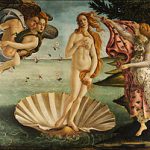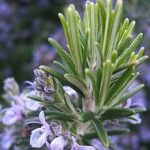 Rosemary began its spiky life on the cliffs and in the crevices of the Mediterranean coast, so the sea figures prominently in its lore.
Rosemary began its spiky life on the cliffs and in the crevices of the Mediterranean coast, so the sea figures prominently in its lore.
In Latin rosemary means “dew of the sea.” Mist from the sea helped it thrive in the rocky coastal landscape of the Mediterranean.

Greek Aphrodite as Roman Venus
In Greek mythology, Aphrodite was born from the sea. She rose up from the foaming waves adorned with garlands of rosemary. Aphrodite is the Greek goddess of love, beauty, and pleasure. Rosemary has also been symbolic for remembrance and loyalty, and it has also been used in weddings and funerals in ages past.
Our human history with rosemary has many branches. Shakespeare mentions it in Hamlet and in Romeo and Juliet, and rosemary was used for protection during the Black Plague in a concoction called Thieves Oil.
There are three varieties of rosemary that you may see in aromatherapy:
Rosmarinus officinalis ct. cineole
Rosmarinus officinalis ct. verbenone
Rosmarinus officinalis ct. camphor
In the names there above, “ct.” stands for “chemotype,” which simply means variety. Chemotypes, or varieties, in rosemary occur because of conditions like inherent plant variety, light, soil, location, and temperature of where it is grown.
 Mostly you will see the first two oils (the variety of cineole or verbenone) available for purchase. The third variety is high in camphor, not used quite as often, and is not as aromatically inviting as the first two. Please avoid the camphor variety of rosemary if you have epilepsy, and all rosemary essential oil if you are pregnant or have asthma.
Mostly you will see the first two oils (the variety of cineole or verbenone) available for purchase. The third variety is high in camphor, not used quite as often, and is not as aromatically inviting as the first two. Please avoid the camphor variety of rosemary if you have epilepsy, and all rosemary essential oil if you are pregnant or have asthma.
Rosmarinus officinalis ct. cineole I used this oil to wake up on a sleepy summer afternoon while I was working on a writing project after lunch. I found it to be a very effective stimulant.
Rosmarinus officinalis ct. verbenone
Rosmarinus officinalis ct. camphor This rosemary can be used similarly to the two other varieties above. It has a stronger camphor smell and should not be used with children.
Source: Harding, J. (2010). The Essential Oils Handbook, New York, NY: Sterling Publishing Co., Inc. pp. 112-113; Schnaubelt, K., PhD (2011). The Healing Intelligence of Essential Oils. Rochester, VT: Healing Arts Press. pp.68-70; Haas, M. (2004). Quick Reference Guide for 114 Important Essential Oils, San Rafael, CA: Terra Linda Scent and Image. pp. 94,95,96.
Image: photo of sea by Fourat / CC-BY-SA-3.0; photo of rosemary by Thor CC-BY-2.0
Articles copyright of Rebecca Mitchell-Guthrie and not to be reprinted without permission.
The information presented on this site is not intended to diagnose health problems or to take the place of professional medical care. The information contained therein is neither intended to dictate what constitutes reasonable, appropriate, or best care for any given health issue, nor is it intended to be used as a substitute for the independent judgment of a physician for any given health issue. All content, including text, graphics, images and information, contained on or available through my web site is for general information purposes only.
